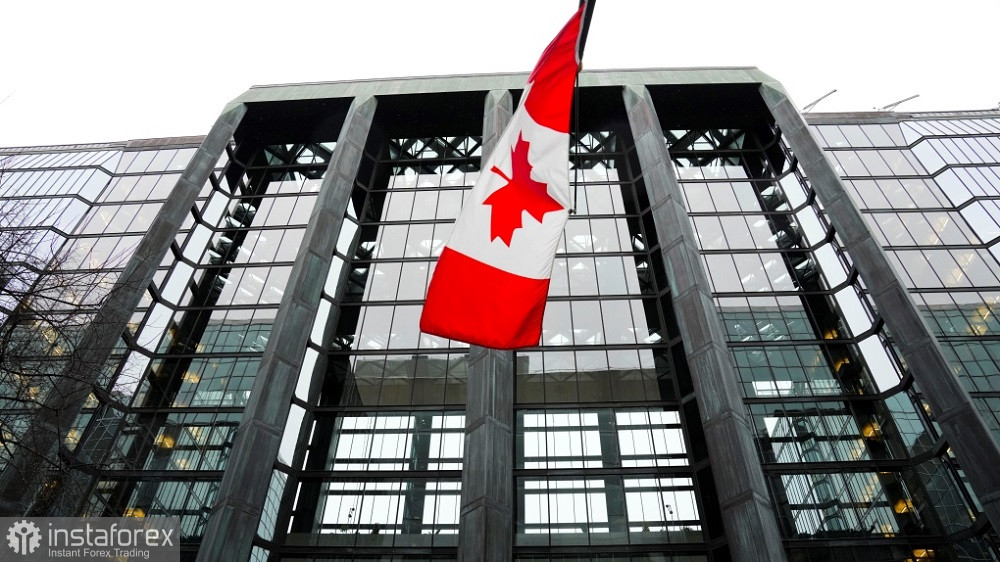On Wednesday, January 24, the Bank of Canada concluded its inaugural meeting of the year. While adhering to the anticipated market consensus, the regulator maintained the status quo on all aspects of monetary policy. However, subtle signals emanating from the Central Bank did not favor the Canadian dollar. Traders swiftly responded, causing the USD/CAD pair to establish a new weekly high and consolidate around the 1.35 level. If this week's pivotal releases, including the US GDP and the core PCE index, fail to exert downward pressure on the greenback, the pair's upward trajectory could target 1.3570 and 1.3610. These levels correspond to the upper Bollinger Bands on the D1 timeframe and the upper limit of the Kumo cloud, respectively.

Examining the weekly USD/CAD chart reveals a persistent northward trend for the fourth consecutive week. After hitting a 5-month price low of 1.3176 at the end of December, the pair experienced a dramatic turnaround at the beginning of the year, dropping nearly 400 points. This shift is primarily attributed to the strengthening of the greenback, as market sentiment towards the Fed's actions turned less dovish, allowing dollar bulls to reassert themselves. Additionally, heightened anti-risk sentiment due to events in the Middle East contributed to the strengthening of the American currency, leaving the Canadian dollar with no counterarguments for a "counterattack."
Despite hopes among USD/CAD sellers for a more hawkish stance from the Bank of Canada in their January meeting, the central bank's dovish signals had a notable impact on the national currency. The anticipation was fueled by recent reports of rising inflation in Canada, with the overall consumer price index accelerating to 3.4% in December, marking the strongest growth since September the previous year. However, the core index, excluding volatile energy and food prices, dipped to 2.6% year on year.
The prevailing expectation was that the Bank of Canada might adopt a "moderately hawkish" position, dismissing the possibility of interest rate cuts. Contrary to these assumptions, the central bank's rhetoric remained dovish, leading to downward pressure on the Canadian dollar.
During the meeting, Bank of Canada Chair Tiff Macklem shifted the focus from debating whether the interest rate had been raised enough to discussing how long the rate should be maintained at the current level. This key statement hinted at a potential future rate cut, contrary to previous expectations.
Analysts, including those at the Royal Bank of Canada, observed a noticeable softening in Macklem's tone, reinforcing the belief that a rate cut might be more likely than a rate hike. Although Macklem didn't specify the timing for potential monetary policy easing, the market independently projected April as a possible date for the first rate cut, contingent on inflation not gaining momentum in the coming months.
The dovish sentiment from the Bank of Canada impacted the USD/CAD pair, leading to impulsive growth that, however, struggled to breach the resistance level of 1.3530 (the lower limit of the Kumo cloud on the daily chart). Bullish sentiment persists, with the USD/CAD pair positioned above all lines of the Bollinger Bands and Ichimoku indicator on the four-hour chart, signaling a bullish trend.
The current indecision among buyers is attributed to crucial macroeconomic reports scheduled for release in the United States, which could influence the behavior of the American currency. Forecasts predict a 2.0% growth in the US economy in the fourth quarter, with the core PCE index declining to 3.0%. Positive results exceeding expectations may provide significant support for the dollar. In such a scenario, the USD/CAD pair could not only surpass the resistance level of 1.3610 (the upper limit of the Kumo cloud on the D1 timeframe), establishing a foothold around the 36th figure, but also pave the way for the 37-38 figure range.
Consequently, the fate of the northern trend hinges on the actions of dollar bulls. The Canadian dollar is compelled to trail the greenback due to the dovish stance of the Bank of Canada. Thus, attention is directed towards upcoming American releases, and trading decisions will be made based on their outcomes.





















